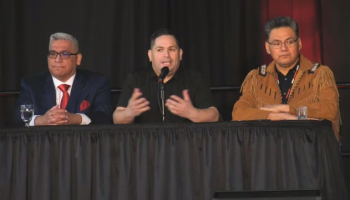Image Caption
Summary
Local Journalism Initiative Reporter
Windspeaker.com
Remote nations in northern Alberta have joined those in Ontario, Manitoba, Saskatchewan and the Northwest Territories in an organization of First Nations that share the challenges and barriers faced by their geographical locations.
“Remoteness has always been an issue within the Treaty 8 First Nations in northern Alberta,” said Loon Lake Chief Ivan Sawan, who signed onto the constitution of the National Assembly of Remote Communities (NARC) on behalf of Treaty 8 on Feb. 21, the first day of NARC’s second annual conference taking place in Edmonton.
Sawan said he saw value in Treaty 8 being part of NARC as the single voice of the organization was “powerful” when it came to dealing with both levels of government.
NARC was formed in 2021 through the Global Resolution Negotiations. It’s an agreement-in-principle that addressed outstanding claims against Canada for discrimination in the delivery of services for First Nations families and children on reserve. The result was a $40-billion settlement that included $20 billion in compensation and $20 billion to help reform child welfare in First Nation communities over five years.
NARC’s mandate is to ensure long-term reforms in funding, programs and services for children and family services meet the unique needs of remote and northern communities.
However, Nishnawbe Aski Nation (NAN) Grand Chief Alvin Fiddler, says NARC could be a “vehicle of change” in more than a single area.
Of the 49 communities that comprise NAN, 34 are fly-in and the rest experience varying degrees of remoteness. NAN is one of the initial signatories to NARC.
“It's not just to change the funding structures for child welfare. But as we crunch these numbers and figure out what is the actual true cost of delivering a program and service in the remote north, the funding structures, the policies, the legislation, whether it's provincial, federal, it needs to reflect that. That is the only way that we can begin to address those gaps that we are all struggling with in our communities right now,” said Fiddler.
To address the needs of long-term child and family reform for northern communities, a remoteness quotient adjustment factor must be developed.
The concept of a remoteness quotient was introduced by NAN during the child welfare proceedings initiated by First Nations Child & Family Caring Society of Canada against Canada, and which went before the Canadian Human Rights Tribunal. An agreement for the creation of the remoteness quotient table was signed by NAN and the federal government in 2017.
Member nations attending this week’s conference will continue the task of developing the remoteness quotient.
“Our plan, and we haven't told Canada yet…is to use that funding framework specific to child welfare and put it on every sector of funding when it comes to our funding across our northern member nations and that would cover education and health and justice and so on and so forth across the board,” said NARC co-chair David Pratt, first vice chief of the Federation of Sovereign Indigenous Nations. FSIN is also a signatory to NARC.
Sawan pointed out that Treaty 8 Nations struggle with emergency services and infrastructure, such as roads, and do not benefit from the “billions and billions of dollars” worth of resources extracted from their traditional lands by Alberta and Canada.
“When we start talking about remoteness and the remoteness factor, that's where we need to hold Alberta and Canada…accountable…Those generated revenues of trillions of dollars that's leaving our backyard needs to stay with First Nations communities,” said Sawan. “We need to be able to not only focus on remoteness, but the extraction of resources from our community. Those go hand in hand.”
NAN Deputy Grand Chief and NARC co-chair Bobby Narcisse acknowledged that there were ongoing regional processes and treaty or self-government negotiations and NARC was not there to “take over any of those areas. We're here to support and look at politically how we can advocate together…for the needs of many of our communities that always get the short end of the stick in terms of (how) we're still living. Many of our communities are still considered by the larger population that we’re in third world…living conditions.”
Those attending the meeting talked about the unreliability of ice roads, which have been impacted severely over the years by climate change, as well as the exorbitant cost of flying in and out of remote communities, with flights often cancelled due to weather conditions.
Other issues raised were the high cost of living; the high cost of fuel; lack of food on store shelves; poor infrastructure, including housing and water; inability to get services; inability to attract and retain qualified professionals; and the closure of Canada Post for lengthy periods, impacting cheques that residents rely on.
The assembly continues today and tomorrow.

